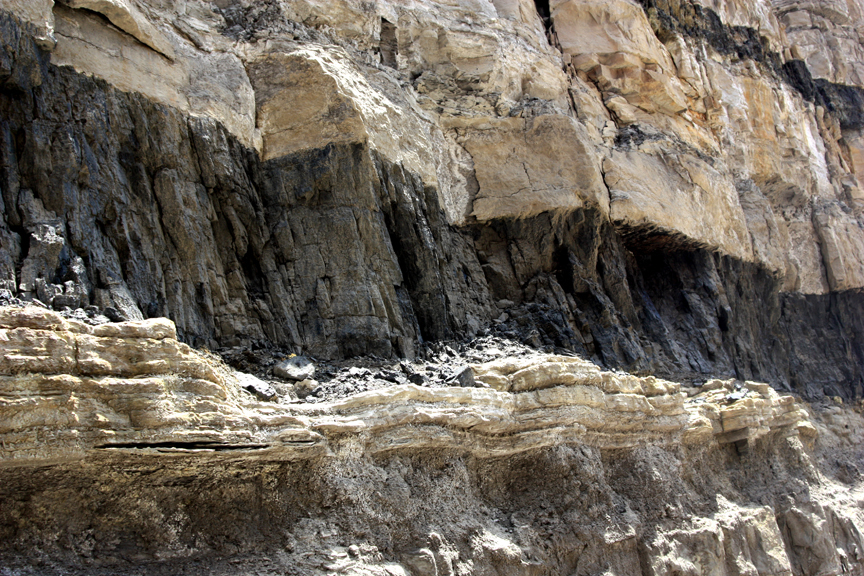Logging Tasks
Walk to the location of the cache from the parking spot. Be safe! At this time there is a barrier to keep rocks from rolling into the road (and cars rolling into cachers)
As you approache you will note the darker and lighter bands, and you will need to pick up a small (thin ) piece from the black stone. Before you try and burn it, please take the piece home or back to the parking area.
- What differences do you see from the grey bands below and aboveto the darker (black) bands.
- Try and light the black stone on fire. (match, candle, torch be safe, it may pop). Did it burn, smoke, what were the results?
- Do you think it is a fine grain mudstone, black shale, or a lignite coal?
- Add a photo of you from the location or of an identifiable item (paper with trackable name). Posting a photo pulled from the internet, or photoshopped will result in instant deletion.

Carbon in the Rock
Carbon is not that odd to find in rocks. All around the world you find deep coal seams. South of here there are vast reserves or coal that make up many mines scattered throughout the hills.
In order for coal to form there needs to be a lot of vegetation. With it dying and dropping into swampy water. However, eventually enough vegetation would fall that it would be out of the water, and would rot. Not turning into a layer to form coal. So it requires the water level to rise. Creating many layers of dying material that is constantly being submerged. Then later it is covered and compressed.
Depending on how much carbon (and not silt or clay) is deposited, and the amount of heat and pressure, you get high quality coal that nearly resembles obsidian, to a poor quality that is more like pressed blackened plants.
In some locations there is runoff from these areas, leaves, and other fine materials will decompose and flow out into another location. The carbon flowing into the mud downstream of a swamp is an example. This will be a mud that has a lot of carbon in it. Sometimes it can be heavy with materials and form tar sands, to something that has very little in it and it will form a carboniferous mudstone or shale.
Identify
Lignite
The biggest thing you can look at is if it will burn. Lignite is much like a briquette. It may have visible plant residue in it. However it has not been subjected to the high pressures and baking that the other coals have. It is usually not at the depths of the other coals and it cheaper to mine. It is dirtier than other purer coals.
Carboniferous Mudstone or Black Shale
Black shale or mudstone may have the appearance of a lignite or other coal from a distance, except that it will not burn. The carbon content is much lower and it will be mixed with other sand/silts. Under heat it may get hot, and radiate from the carbon, but will not "burn" when the heat it taken away. (though it may remain hot for some time)
Mudstones and shales are made of silt- and clay-sized particles that are too small to see. The only difference between mudstone and shale is that mudstones break into blocky pieces whereas shales break into thin chips with roughly parallel tops and bottoms. Both are made of ancient mud.
